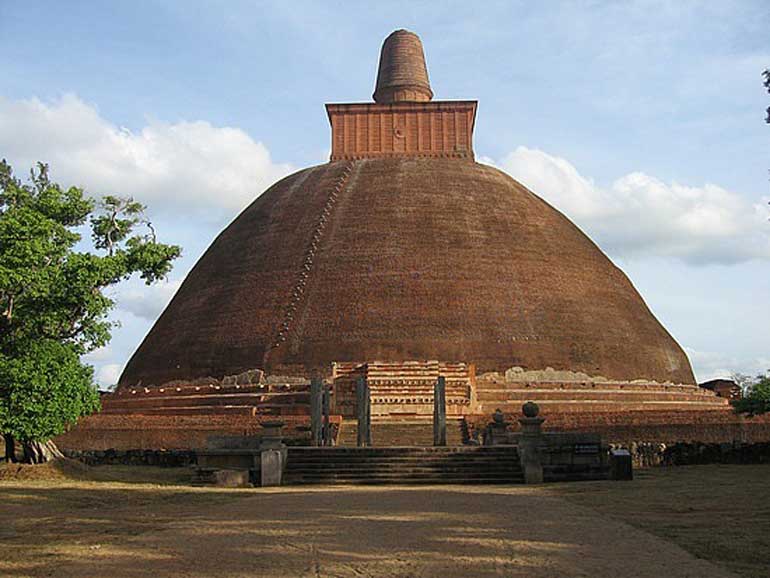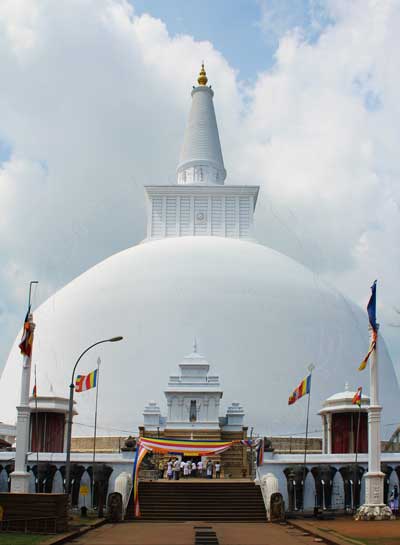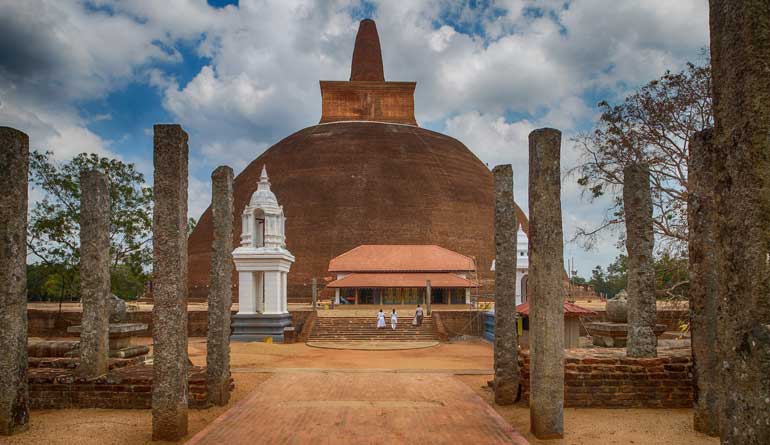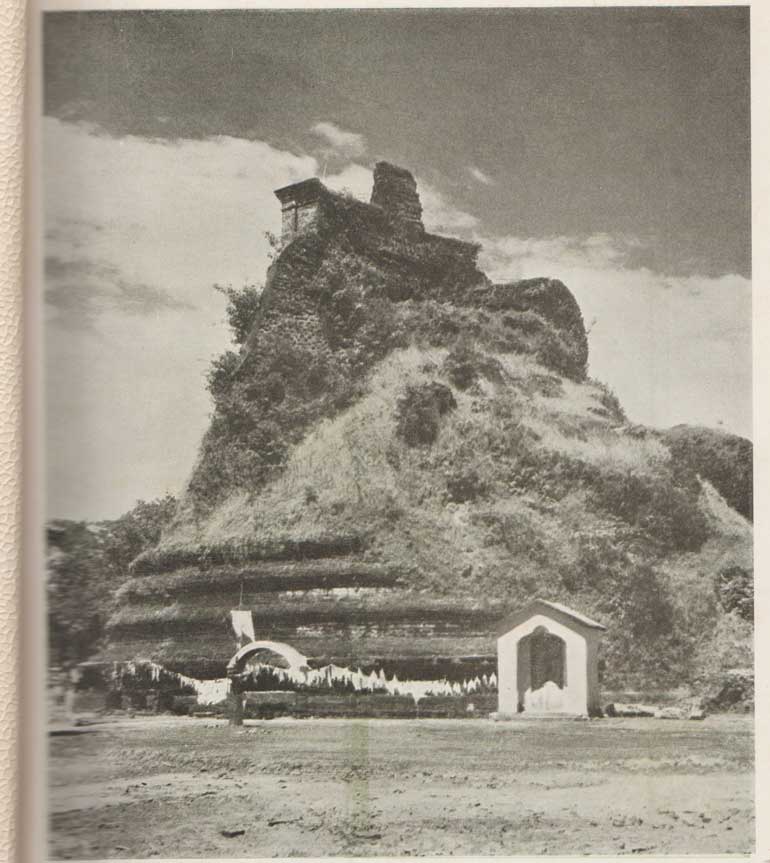Friday Jan 02, 2026
Friday Jan 02, 2026
Saturday, 8 August 2015 00:00 - - {{hitsCtrl.values.hits}}

Abhayagiri today
By D.C. Ranatunga
Anuradhapura is slowly but surely getting back to its days of glory. The Abhayagiri dagaba is the latest to be brought back to its former status. Jetavana dagaba and Mirisawetiya have been completed. All three were weather-worn stupas not so long ago. The Central Cultural Fund is steadily completing its tasks in the historic city.
The grandeur that was Anuradhapura, the first capital of Sri Lanka, has been described by foreign visitors and experts vividly. Well-known author on archaeological subjects, Leonard Coutrell writes that many of the old monuments at Anuradhapura were begun at a time contemporary with the conquests of Alexander the Great and his successors, and continued throughout the period of the Roman Empire.
He states: “Yet even the greatest architectural achievements of the Roman emperors cannot compare in size with the finest works of the Sinhalese kings who were their contemporaries. The area of Anuradhapura, for instance, was 250 square miles; the palaces of monarchs such as Dutthagamani, as described by the ancient Sinhalese writers, would have made Diocletian’s palace seem a poor thing by comparison; their great dagabas, artificial hills of masonry supporting shrines and reliquaries were sometimes over 300 feet in height and can be compared with the pyramids of Egypt. Their hydraulic engineering have no parallel save in the nineteenth and twentieth centuries; for example, the lake at Minneriya created at the third century A.D. by Maha Sen, had a circumference of twenty miles, and the masonry and the masonry and earthwork dams which were made to divert the waters which fills it, extend for eighty miles; their average height is eighty feet.”
 Abhayagiri monastery
Abhayagiri monastery
The Abhayagiri monastery dates back to the time of King Vattagmani Abhaya (Valagamba) during his second reign (89-77 BC). The Mahavamsa, the Great Chronicle, relates the story of how the king had to flee the capital after ascending the throne in 109 BC when was threatened by the invading Tamils.
As he abandoned the throne and was fleeing a ‘nigantha’ (Jaina monk) named Giri who was in his hermitage is said to have shouted insultingly, “The great black Sinhalese lion is running away.”
The king went into hiding in the hills. Having built up his troops, after 14 years he matched to Anuradhapura in 89 BC and defeated the ruling king Bhatiya and got back the throne. He remembered the insult and when he returned victorious he razed the hermitage to the ground and in its place built a dagaba and 12 buildings as residences for monks. He named the monastery ‘Abhayagiri’ by the combination of his name Abhaya with the nigantha’s name Giri and bestowed it to Mahatissa Thera as a token of gratitude during his period of adversity. In the years that followed, the monastery developed as a well-recognised seat of learning.
Chinese monk Fa-Hsien who came on a visit to Sri Lanka in the fifth century AC states that he noticed around 5,000 monks residing at the monastery compared to 3,000 monks at Mahavihara, the monastery established earlier.
Abhayagiri dagaba
The place where the Abhayagiri dagaba was constructed has been accepted as one of the 16 places visited by the Buddha. Thus it has been built over a foot impression of the Buddha.
The original height of the Abhayagiri dagaba had been 113 metres in height but over time it had come down to 75 metres. It is only second in height to Jetavana dagaba at a height of 120m which incidentally is the world’s third tallest edifice after the two tallest pyramids in Egypt. Jetavana dagaba is the tallest Buddhist stupa in the world and is also the world’s tallest-ever building built of brick. Once the ruins in Anuradhapura were restored, the city became the most visited place of worship by Buddhist pilgrims. In addition to the devotion of the pilgrims, the easy accessibility from any part of the country has made Anuradhapura so popular.

Jetavanarama dagaba
Childhood trips to Anuradhapura
For me, going to Anuradhapura was a regular family trip from my childhood days. The early trips were by train using warrants my father was entitled to as a teacher in a government school when we could go by train free of charge.
The number of warrants for a year depended on the service and rank of the public official concerned. Looking back that was that was the only perk my father enjoyed as the headmaster of a bilingual school. He was entitled to a certain number of warrants to travel in the second class. During the school holidays we would plan an outing by train. Going to Anuradhapura we got in to the train from Gampaha and reached Anuradhapura in a few hours. We used to stay in a hotel – it was the pre-luxury hotel era but there were decent hotels with a few rooms upstairs and the restaurant downstairs.
We got about in a hired car. There were no taxis but private cars were available for hire. What usually happened was to hire the vehicle to go round ‘Atamasthana’ on an agreed fare.

‘Atamasthana’
This was in the early 1940s and as a child I was amazed by the huge dagabas in the holy city. While Ruvanveli Seya was the most attractive having been restored fully, the other dagabas were mounds of earth. Yet devotees did not want to miss the eight places of worship and covered the ‘Atamasthana’ every time they visited Anuradhapura. A few decades ago, transport facilities were nowhere near what it is today, ‘Vandana nades’ used the railway for their pilgrimages. The biggest attraction was the dagabas. Van rides are the most popular today. In Professor Senerat Paranavitana’s words: “With their domes of dazzling white, their tapering and graceful spires and their gilded pinnacles, they form a picturesque though familiar feature of the landscape.”